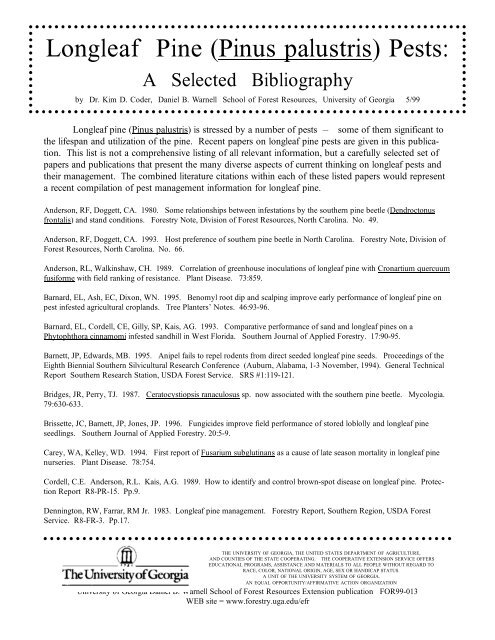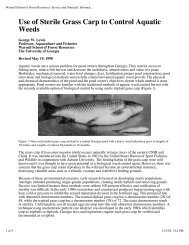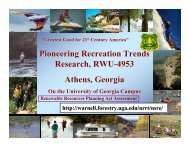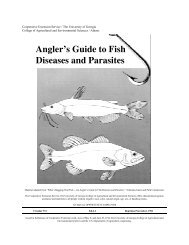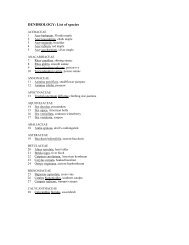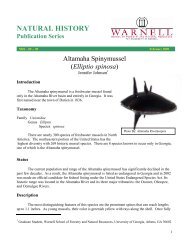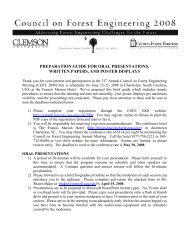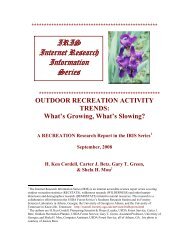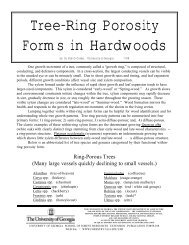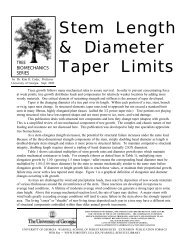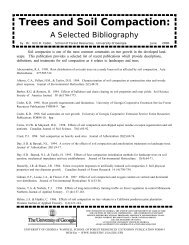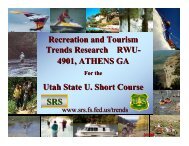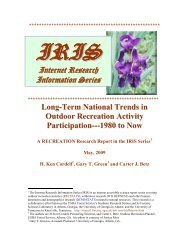Longleaf Pine (Pinus palustris) Pests: - University of Georgia
Longleaf Pine (Pinus palustris) Pests: - University of Georgia
Longleaf Pine (Pinus palustris) Pests: - University of Georgia
Create successful ePaper yourself
Turn your PDF publications into a flip-book with our unique Google optimized e-Paper software.
<strong>Longleaf</strong> <strong>Pine</strong> (<strong>Pinus</strong> <strong>palustris</strong>) <strong>Pests</strong>:A Selected Bibliographyby Dr. Kim D. Coder, Daniel B. Warnell School <strong>of</strong> Forest Resources, <strong>University</strong> <strong>of</strong> <strong>Georgia</strong> 5/99<strong>Longleaf</strong> pine (<strong>Pinus</strong> <strong>palustris</strong>) is stressed by a number <strong>of</strong> pests — some <strong>of</strong> them significant tothe lifespan and utilization <strong>of</strong> the pine. Recent papers on longleaf pine pests are given in this publication.This list is not a comprehensive listing <strong>of</strong> all relevant information, but a carefully selected set <strong>of</strong>papers and publications that present the many diverse aspects <strong>of</strong> current thinking on longleaf pests andtheir management. The combined literature citations within each <strong>of</strong> these listed papers would representa recent compilation <strong>of</strong> pest management information for longleaf pine.Anderson, RF, Doggett, CA. 1980. Some relationships between infestations by the southern pine beetle (Dendroctonusfrontalis) and stand conditions. Forestry Note, Division <strong>of</strong> Forest Resources, North Carolina. No. 49.Anderson, RF, Doggett, CA. 1993. Host preference <strong>of</strong> southern pine beetle in North Carolina. Forestry Note, Division <strong>of</strong>Forest Resources, North Carolina. No. 66.Anderson, RL, Walkinshaw, CH. 1989. Correlation <strong>of</strong> greenhouse inoculations <strong>of</strong> longleaf pine with Cronartium quercuumfusiforme with field ranking <strong>of</strong> resistance. Plant Disease. 73:859.Barnard, EL, Ash, EC, Dixon, WN. 1995. Benomyl root dip and scalping improve early performance <strong>of</strong> longleaf pine onpest infested agricultural croplands. Tree Planters’ Notes. 46:93-96.Barnard, EL, Cordell, CE, Gilly, SP, Kais, AG. 1993. Comparative performance <strong>of</strong> sand and longleaf pines on aPhytophthora cinnamomi infested sandhill in West Florida. Southern Journal <strong>of</strong> Applied Forestry. 17:90-95.Barnett, JP, Edwards, MB. 1995. Anipel fails to repel rodents from direct seeded longleaf pine seeds. Proceedings <strong>of</strong> theEighth Biennial Southern Silvicultural Research Conference (Auburn, Alabama, 1-3 November, 1994). General TechnicalReport Southern Research Station, USDA Forest Service. SRS #1:119-121.Bridges, JR, Perry, TJ. 1987. Ceratocystiopsis ranaculosus sp. now associated with the southern pine beetle. Mycologia.79:630-633.Brissette, JC, Barnett, JP, Jones, JP. 1996. Fungicides improve field performance <strong>of</strong> stored loblolly and longleaf pineseedlings. Southern Journal <strong>of</strong> Applied Forestry. 20:5-9.Carey, WA, Kelley, WD. 1994. First report <strong>of</strong> Fusarium subglutinans as a cause <strong>of</strong> late season mortality in longleaf pinenurseries. Plant Disease. 78:754.Cordell, C.E. Anderson, R.L. Kais, A.G. 1989. How to identify and control brown-spot disease on longleaf pine. ProtectionReport R8-PR-15. Pp.9.Dennington, RW, Farrar, RM Jr. 1983. <strong>Longleaf</strong> pine management. Forestry Report, Southern Region, USDA ForestService. R8-FR-3. Pp.17.THE UNIVERSITY OF GEORGIA, THE UNITED STATES DEPARTMENT OF AGRICULTURE,AND COUNTIES OF THE STATE COOPERATING. THE COOPERATIVE EXTENSION SERVICE OFFERSEDUCATIONAL PROGRAMS, ASSISTANCE AND MATERIALS TO ALL PEOPLE WITHOUT REGARD TORACE, COLOR, NATIONAL ORIGIN, AGE, SEX OR HANDICAP STATUS.A UNIT OF THE UNIVERSITY SYSTEM OF GEORGIA.AN EQUAL OPPORTUNITY/AFFIRMATIVE ACTION ORGANIZATION<strong>University</strong> <strong>of</strong> <strong>Georgia</strong> Daniel B. Warnell School <strong>of</strong> Forest Resources Extension publication FOR99-013WEB site = www.forestry.uga.edu/efr
Doggett, C, Langston, FW, Worley, WL. 1994. Nantucket pine tip moth infests longleaf pine seedlings in a North Carolinanursery. Tree Planters’ Notes. 45: 86-87.Doggett, CA, Smith, T. 1992. Pales weevil: A serious threat to longleaf pine production. Tree Planters’ Notes. 43:87-88.English, J.T. Ploetz, R.C. Barnard, E.L. 1986. Seedling blight <strong>of</strong> longleaf pine caused by a binucleate Rhizoctoniasolani-like fungus. Plant Disease. 70(2):148-150.Esher, RJ, Marx, DH, Ursic, SJ, Baker, RL, Brown, LR, Coleman, DC. 1992. Simulated acid rain effects on fine roots,ectomycorrhizae, microorganisms, and invertebrates in pine forests <strong>of</strong> the southern United States. Water, Air, and SoilPollution. 161:269-278,Farrar, RM Jr. 1990. Proceedings <strong>of</strong> the Symposium on the management <strong>of</strong> longleaf pine. (April 4-6, 1989, Long Beach,Mississippi.) USDA Forest Service. General Technical Report SO-75. Pp. 293.Fatzinger, C.W. Muse, H.D. Miller, T. Bhattacharyya, H. 1990. Survey and pest monitoring system for southern pineseed orchards. Southern Journal <strong>of</strong> Applied Forestry. 14(3):147-154.Funk, A. 1986. Two new Discomycetes on <strong>Pinus</strong>. Mycotaxon. 27:283-288.Gilly, S.P. Barnard, E.L. Schroeder, R.A. 1985. Field trials for control <strong>of</strong> Rhizoctonia blight <strong>of</strong> longleaf pine seedlings:effects <strong>of</strong> seedbed planting densities, fungicides and mulches. Proceedings <strong>of</strong> the International Symposium on NurseryManagement Practices for the Southern <strong>Pine</strong>s. D.B. South, editor. (Montgomery, Alabama, August 4-9, 1985.)Goddard, R.E. Rockwood, D.L. Kok, H.R. 1984. Cooperative Forest Genetics Research Program: 26th Progress Report.Research Report, <strong>University</strong> <strong>of</strong> Florida, School <strong>of</strong> Forest Resources and Conservation. #35. Pp.26.Grelen, H.E. 1983. May burns benefit survival and growth <strong>of</strong> longleaf pine seedlings. USDA Forest Service GeneralTechnical Report SE-24:70-73.Griggs, M.M. Schmidt, R.A. 1986. Disease progress <strong>of</strong> Scirrhia acicola in single and mixed family plantings <strong>of</strong> resistantand susceptible longleaf pine. USDA Forest Service General Technical Report WO. 50:5-10.Hatchell, GE, Marx, DH. 1987. Response <strong>of</strong> longleaf, sand, and loblolly pines to Pisolithus ectomycorrhizae and fertilizeron a sandhills site in South Carolina. Forest Science. 33: 301-315.Hayes, JL, Meeker, JR, Foltz, JL, Strom, BL. 1996. Suppression <strong>of</strong> bark beetles and protection <strong>of</strong> pines in the urbanenvironment: A case study. Journal <strong>of</strong> Arboriculture. 22:67-74.Hooper, RG. 1996. Arthropod biomass in winter and the age <strong>of</strong> longleaf pines. Forest Ecology and Management. 82:115-131.Jewell, F.F. 1986. Histological studies <strong>of</strong> Scirrhia acicola and other needle-inhabiting fungi on longleaf and loblolly pines.USDA Forest Service General Technical Report WO. 50:1-4.Jewell, FF. 1990. Histopathology <strong>of</strong> longleaf pine needles infected by Ploioderma hedgcockii. European Journal <strong>of</strong> ForestPathology. 20:24-31.Jones, JP, Pantone DJ, Barnett JP, Brissette JC. 1992. The relationship between fungal population development and rootdamage <strong>of</strong> cold stored longleaf pine seedlings. Bulletin <strong>of</strong> the Louisiana Agricultural Experiment Station. #832.Kais, A.G. Cordell, C.E. Affeltranger, C.E. 1986. Nursery application <strong>of</strong> benomyl fungicide for field control <strong>of</strong>brown-spot needle blight (Scirrhia acicola) on longleaf pine (<strong>Pinus</strong> palustrus). Tree Planters’ Notes 37(1):5.Kais, A.G. Griggs, M.M. 1986. Control <strong>of</strong> brown spot needle blight infection on longleaf pine through benomyl treatmentand breeding. USDA Forest Service General Technical Report WO. 50:15-19.2
Kohnle, U, Vite, JP, Meyer, H, Francke, W. 1994. Response <strong>of</strong> four American engraver bark beetles, Ips spp. to syntheticracemates <strong>of</strong> chiral pheromones. Journal <strong>of</strong> Applied Entomology. 1994, 117:451-456.Kraus, J.F. 1986. Brown spot needle blight susceptibility <strong>of</strong> longleaf pine seed sources in <strong>Georgia</strong> and Florida. USDAForest Service General Technical Report WO. 50:11-14.Lantz, CW, Barnett, JP, Kais, AG. 1988. Benomyl improves storability and brown spot resistance <strong>of</strong> longleaf pine seedlings.Management Bulletin <strong>of</strong> the Southern Region, USDA Forest Service. R8-MB-17. Pp.2.Lauer, DK. 1987. Seedling size influences early growth <strong>of</strong> longleaf pine. Tree Planters’ Notes. 1987, 38:16-17.Li, CD, Zhu, XQ, Han, ZM, Zhang, JN, Shen, BK, Zhang, ZH, Zheng, WP, Zou, KM, Shi, FY. 1986. Investigation onbrown spot needle blight <strong>of</strong> pines in China. Journal <strong>of</strong> Nanjing Institute <strong>of</strong> Forestry. #2. Pp.11-18,Li, XP, Wang, YJ. 1997. <strong>Pinus</strong> strobus var. chiapensis and other exotic pines: Investigation and analysis <strong>of</strong> naturalnematode infections and death. Journal <strong>of</strong> Zhejiang Forestry College. 14:273-276.Lipscomb, D.J. 1989. Impacts <strong>of</strong> feral hogs on longleaf pine regeneration. Southern Journal <strong>of</strong> Applied Forestry.13(4):177-181.Lott, LH, Schmidtling, RC, Snow, GA. 1997. Susceptibility to brown spot needle blight and fusiform rust in selectedlongleaf pine and hybrids. Tree Planters’ Notes. 47:11-15.Otrosina, WJ, Hess, NJ, Zarnoch, SJ, Perry, TJ, Jones, JP. 1997. Blue stain fungi associated with roots <strong>of</strong> southern pinetrees attacked by the southern pine beetle, Dendroctonus frontalis. Plant Disease. 81:942-945.Peterson, GW. 1986. Recent research on conifer needle diseases. USDA Forest Service, GTR WO-50. Pp.106.Runion, G.B. Bruck, R.I. 1988. Effects <strong>of</strong> thiabendazole-DMSO treatment <strong>of</strong> longleaf pine seed contaminated withFusarium subglutinans on germination and seedling survival. Plant Disease. 72(10):872-874.Runion, GB, Kelley, WD, Land, DH, Gilly, SP, Sharp, DJ. 1994. Chemical control <strong>of</strong> Rhizoctonia seedling blight <strong>of</strong>longleaf pine. Southern Journal <strong>of</strong> Applied Forestry. 18: 5-9.Siegfried, BD. 1987. In flight responses <strong>of</strong> the pales weevil, Hylobius pales to monoterpene constituents <strong>of</strong> southern pinegum turpentine. Florida Entomologist. 70:97-102.Sluder, E.R. 1983. Three increments <strong>of</strong> gain from three stages <strong>of</strong> selection in slash and longleaf pines and heritabilities atage 21 years. Proceedings <strong>of</strong> the Southern Forest Tree Improvement Conference. #39: 253-261.Sluder, E.R. 1986. Gains from first-cycle selection in slash and longleaf pines. Silvae Genetica. 35(4):155-159.South, DB, Loewenstein, NJ. 1994. Effects <strong>of</strong> Viterra root dips and benomyl on root growth potential and survival <strong>of</strong>longleaf pine seedlings. Southern Journal <strong>of</strong> Applied Forestry. 18:19-23.Suga, T, Ohta, S, Munesada, K, Ide, N, Kurokawa, M, Shimizu, M, Ohta, E. 1993. Endogenous pine wood nematicidalsubstances in pines, <strong>Pinus</strong> massoniana, P. strobus and P. <strong>palustris</strong>. Phytochemistry. 33:1395-1401.Taylor, A.D. Hayes, J.L. Roton, L. Moser, J.C. 1992. A phloem sandwich allowing attack and colonization by barkbeetles and associates. Journal <strong>of</strong> Entomological Science. 27(4):311-316.Twardus, D, Taylor, S. 1975. Attractant/bait traps for the pales weevil (Hylobius pales): Effect <strong>of</strong> pine species and trapsize. Forestry Note #22. Division <strong>of</strong> Forest Resources, North Carolina.3
<strong>Longleaf</strong> <strong>Pine</strong> (<strong>Pinus</strong> <strong>palustris</strong>) <strong>Pests</strong>:A Selected Bibliographyby Dr. Kim D. Coder, Daniel B. Warnell School <strong>of</strong> Forest Resources, <strong>University</strong> <strong>of</strong> <strong>Georgia</strong> 5/99<strong>Longleaf</strong> pine (<strong>Pinus</strong> <strong>palustris</strong>) is stressed by a number <strong>of</strong> pests — some <strong>of</strong> them significant tothe lifespan and utilization <strong>of</strong> the pine. Recent papers on longleaf pine pests are given in this publication.This list is not a comprehensive listing <strong>of</strong> all relevant information, but a carefully selected set <strong>of</strong>papers and publications that present the many diverse aspects <strong>of</strong> current thinking on longleaf pests andtheir management. The combined literature citations within each <strong>of</strong> these listed papers would representa recent compilation <strong>of</strong> pest management information for longleaf pine.Anderson, RF, Doggett, CA. 1980. Some relationships between infestations by the southern pine beetle (Dendroctonusfrontalis) and stand conditions. Forestry Note, Division <strong>of</strong> Forest Resources, North Carolina. No. 49.Anderson, RF, Doggett, CA. 1993. Host preference <strong>of</strong> southern pine beetle in North Carolina. Forestry Note, Division <strong>of</strong>Forest Resources, North Carolina. No. 66.Anderson, RL, Walkinshaw, CH. 1989. Correlation <strong>of</strong> greenhouse inoculations <strong>of</strong> longleaf pine with Cronartium quercuumfusiforme with field ranking <strong>of</strong> resistance. Plant Disease. 73:859.Barnard, EL, Ash, EC, Dixon, WN. 1995. Benomyl root dip and scalping improve early performance <strong>of</strong> longleaf pine onpest infested agricultural croplands. Tree Planters’ Notes. 46:93-96.Barnard, EL, Cordell, CE, Gilly, SP, Kais, AG. 1993. Comparative performance <strong>of</strong> sand and longleaf pines on aPhytophthora cinnamomi infested sandhill in West Florida. Southern Journal <strong>of</strong> Applied Forestry. 17:90-95.Barnett, JP, Edwards, MB. 1995. Anipel fails to repel rodents from direct seeded longleaf pine seeds. Proceedings <strong>of</strong> theEighth Biennial Southern Silvicultural Research Conference (Auburn, Alabama, 1-3 November, 1994). General TechnicalReport Southern Research Station, USDA Forest Service. SRS #1:119-121.Bridges, JR, Perry, TJ. 1987. Ceratocystiopsis ranaculosus sp. now associated with the southern pine beetle. Mycologia.79:630-633.Brissette, JC, Barnett, JP, Jones, JP. 1996. Fungicides improve field performance <strong>of</strong> stored loblolly and longleaf pineseedlings. Southern Journal <strong>of</strong> Applied Forestry. 20:5-9.Carey, WA, Kelley, WD. 1994. First report <strong>of</strong> Fusarium subglutinans as a cause <strong>of</strong> late season mortality in longleaf pinenurseries. Plant Disease. 78:754.Cordell, C.E. Anderson, R.L. Kais, A.G. 1989. How to identify and control brown-spot disease on longleaf pine. ProtectionReport R8-PR-15. Pp.9.Dennington, RW, Farrar, RM Jr. 1983. <strong>Longleaf</strong> pine management. Forestry Report, Southern Region, USDA ForestService. R8-FR-3. Pp.17.THE UNIVERSITY OF GEORGIA, THE UNITED STATES DEPARTMENT OF AGRICULTURE,AND COUNTIES OF THE STATE COOPERATING. THE COOPERATIVE EXTENSION SERVICE OFFERSEDUCATIONAL PROGRAMS, ASSISTANCE AND MATERIALS TO ALL PEOPLE WITHOUT REGARD TORACE, COLOR, NATIONAL ORIGIN, AGE, SEX OR HANDICAP STATUS.A UNIT OF THE UNIVERSITY SYSTEM OF GEORGIA.AN EQUAL OPPORTUNITY/AFFIRMATIVE ACTION ORGANIZATION<strong>University</strong> <strong>of</strong> <strong>Georgia</strong> Daniel B. Warnell School <strong>of</strong> Forest Resources Extension publication FOR99-013WEB site = www.forestry.uga.edu/efr
Doggett, C, Langston, FW, Worley, WL. 1994. Nantucket pine tip moth infests longleaf pine seedlings in a North Carolinanursery. Tree Planters’ Notes. 45: 86-87.Doggett, CA, Smith, T. 1992. Pales weevil: A serious threat to longleaf pine production. Tree Planters’ Notes. 43:87-88.English, J.T. Ploetz, R.C. Barnard, E.L. 1986. Seedling blight <strong>of</strong> longleaf pine caused by a binucleate Rhizoctoniasolani-like fungus. Plant Disease. 70(2):148-150.Esher, RJ, Marx, DH, Ursic, SJ, Baker, RL, Brown, LR, Coleman, DC. 1992. Simulated acid rain effects on fine roots,ectomycorrhizae, microorganisms, and invertebrates in pine forests <strong>of</strong> the southern United States. Water, Air, and SoilPollution. 161:269-278,Farrar, RM Jr. 1990. Proceedings <strong>of</strong> the Symposium on the management <strong>of</strong> longleaf pine. (April 4-6, 1989, Long Beach,Mississippi.) USDA Forest Service. General Technical Report SO-75. Pp. 293.Fatzinger, C.W. Muse, H.D. Miller, T. Bhattacharyya, H. 1990. Survey and pest monitoring system for southern pineseed orchards. Southern Journal <strong>of</strong> Applied Forestry. 14(3):147-154.Funk, A. 1986. Two new Discomycetes on <strong>Pinus</strong>. Mycotaxon. 27:283-288.Gilly, S.P. Barnard, E.L. Schroeder, R.A. 1985. Field trials for control <strong>of</strong> Rhizoctonia blight <strong>of</strong> longleaf pine seedlings:effects <strong>of</strong> seedbed planting densities, fungicides and mulches. Proceedings <strong>of</strong> the International Symposium on NurseryManagement Practices for the Southern <strong>Pine</strong>s. D.B. South, editor. (Montgomery, Alabama, August 4-9, 1985.)Goddard, R.E. Rockwood, D.L. Kok, H.R. 1984. Cooperative Forest Genetics Research Program: 26th Progress Report.Research Report, <strong>University</strong> <strong>of</strong> Florida, School <strong>of</strong> Forest Resources and Conservation. #35. Pp.26.Grelen, H.E. 1983. May burns benefit survival and growth <strong>of</strong> longleaf pine seedlings. USDA Forest Service GeneralTechnical Report SE-24:70-73.Griggs, M.M. Schmidt, R.A. 1986. Disease progress <strong>of</strong> Scirrhia acicola in single and mixed family plantings <strong>of</strong> resistantand susceptible longleaf pine. USDA Forest Service General Technical Report WO. 50:5-10.Hatchell, GE, Marx, DH. 1987. Response <strong>of</strong> longleaf, sand, and loblolly pines to Pisolithus ectomycorrhizae and fertilizeron a sandhills site in South Carolina. Forest Science. 33: 301-315.Hayes, JL, Meeker, JR, Foltz, JL, Strom, BL. 1996. Suppression <strong>of</strong> bark beetles and protection <strong>of</strong> pines in the urbanenvironment: A case study. Journal <strong>of</strong> Arboriculture. 22:67-74.Hooper, RG. 1996. Arthropod biomass in winter and the age <strong>of</strong> longleaf pines. Forest Ecology and Management. 82:115-131.Jewell, F.F. 1986. Histological studies <strong>of</strong> Scirrhia acicola and other needle-inhabiting fungi on longleaf and loblolly pines.USDA Forest Service General Technical Report WO. 50:1-4.Jewell, FF. 1990. Histopathology <strong>of</strong> longleaf pine needles infected by Ploioderma hedgcockii. European Journal <strong>of</strong> ForestPathology. 20:24-31.Jones, JP, Pantone DJ, Barnett JP, Brissette JC. 1992. The relationship between fungal population development and rootdamage <strong>of</strong> cold stored longleaf pine seedlings. Bulletin <strong>of</strong> the Louisiana Agricultural Experiment Station. #832.Kais, A.G. Cordell, C.E. Affeltranger, C.E. 1986. Nursery application <strong>of</strong> benomyl fungicide for field control <strong>of</strong>brown-spot needle blight (Scirrhia acicola) on longleaf pine (<strong>Pinus</strong> palustrus). Tree Planters’ Notes 37(1):5.Kais, A.G. Griggs, M.M. 1986. Control <strong>of</strong> brown spot needle blight infection on longleaf pine through benomyl treatmentand breeding. USDA Forest Service General Technical Report WO. 50:15-19.2
Kohnle, U, Vite, JP, Meyer, H, Francke, W. 1994. Response <strong>of</strong> four American engraver bark beetles, Ips spp. to syntheticracemates <strong>of</strong> chiral pheromones. Journal <strong>of</strong> Applied Entomology. 1994, 117:451-456.Kraus, J.F. 1986. Brown spot needle blight susceptibility <strong>of</strong> longleaf pine seed sources in <strong>Georgia</strong> and Florida. USDAForest Service General Technical Report WO. 50:11-14.Lantz, CW, Barnett, JP, Kais, AG. 1988. Benomyl improves storability and brown spot resistance <strong>of</strong> longleaf pine seedlings.Management Bulletin <strong>of</strong> the Southern Region, USDA Forest Service. R8-MB-17. Pp.2.Lauer, DK. 1987. Seedling size influences early growth <strong>of</strong> longleaf pine. Tree Planters’ Notes. 1987, 38:16-17.Li, CD, Zhu, XQ, Han, ZM, Zhang, JN, Shen, BK, Zhang, ZH, Zheng, WP, Zou, KM, Shi, FY. 1986. Investigation onbrown spot needle blight <strong>of</strong> pines in China. Journal <strong>of</strong> Nanjing Institute <strong>of</strong> Forestry. #2. Pp.11-18,Li, XP, Wang, YJ. 1997. <strong>Pinus</strong> strobus var. chiapensis and other exotic pines: Investigation and analysis <strong>of</strong> naturalnematode infections and death. Journal <strong>of</strong> Zhejiang Forestry College. 14:273-276.Lipscomb, D.J. 1989. Impacts <strong>of</strong> feral hogs on longleaf pine regeneration. Southern Journal <strong>of</strong> Applied Forestry.13(4):177-181.Lott, LH, Schmidtling, RC, Snow, GA. 1997. Susceptibility to brown spot needle blight and fusiform rust in selectedlongleaf pine and hybrids. Tree Planters’ Notes. 47:11-15.Otrosina, WJ, Hess, NJ, Zarnoch, SJ, Perry, TJ, Jones, JP. 1997. Blue stain fungi associated with roots <strong>of</strong> southern pinetrees attacked by the southern pine beetle, Dendroctonus frontalis. Plant Disease. 81:942-945.Peterson, GW. 1986. Recent research on conifer needle diseases. USDA Forest Service, GTR WO-50. Pp.106.Runion, G.B. Bruck, R.I. 1988. Effects <strong>of</strong> thiabendazole-DMSO treatment <strong>of</strong> longleaf pine seed contaminated withFusarium subglutinans on germination and seedling survival. Plant Disease. 72(10):872-874.Runion, GB, Kelley, WD, Land, DH, Gilly, SP, Sharp, DJ. 1994. Chemical control <strong>of</strong> Rhizoctonia seedling blight <strong>of</strong>longleaf pine. Southern Journal <strong>of</strong> Applied Forestry. 18: 5-9.Siegfried, BD. 1987. In flight responses <strong>of</strong> the pales weevil, Hylobius pales to monoterpene constituents <strong>of</strong> southern pinegum turpentine. Florida Entomologist. 70:97-102.Sluder, E.R. 1983. Three increments <strong>of</strong> gain from three stages <strong>of</strong> selection in slash and longleaf pines and heritabilities atage 21 years. Proceedings <strong>of</strong> the Southern Forest Tree Improvement Conference. #39: 253-261.Sluder, E.R. 1986. Gains from first-cycle selection in slash and longleaf pines. Silvae Genetica. 35(4):155-159.South, DB, Loewenstein, NJ. 1994. Effects <strong>of</strong> Viterra root dips and benomyl on root growth potential and survival <strong>of</strong>longleaf pine seedlings. Southern Journal <strong>of</strong> Applied Forestry. 18:19-23.Suga, T, Ohta, S, Munesada, K, Ide, N, Kurokawa, M, Shimizu, M, Ohta, E. 1993. Endogenous pine wood nematicidalsubstances in pines, <strong>Pinus</strong> massoniana, P. strobus and P. <strong>palustris</strong>. Phytochemistry. 33:1395-1401.Taylor, A.D. Hayes, J.L. Roton, L. Moser, J.C. 1992. A phloem sandwich allowing attack and colonization by barkbeetles and associates. Journal <strong>of</strong> Entomological Science. 27(4):311-316.Twardus, D, Taylor, S. 1975. Attractant/bait traps for the pales weevil (Hylobius pales): Effect <strong>of</strong> pine species and trapsize. Forestry Note #22. Division <strong>of</strong> Forest Resources, North Carolina.3


